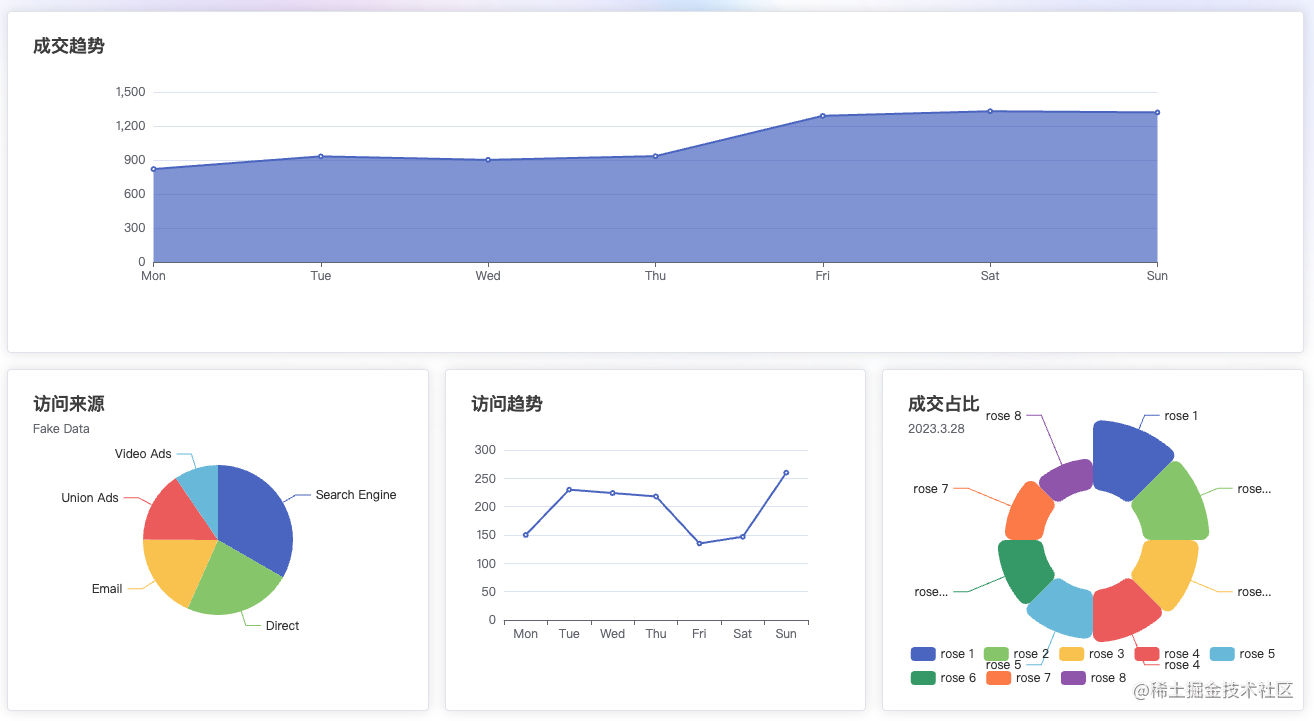图表统计作为后台管理系统标配当然不能少,本项目选择使用最熟悉的eCharts。
eCharts完整包太大了,一般项目中只会使用其中小部分图表,所以我们只用按需引入,尽量减少打包体积。

首先安装eCharts
npm install echarts --save
在src/components 文件夹下新建目录echarts,新建文件echarts.ts。
本项目只简单使用了eChart的几个基本图表,如果你的需求比较复杂需要更多图表组件,可以修改echarts.ts中引入的组件
import * as echarts from 'echarts/core'
/**
引入需要的图表,需要什么就加什么
*/
import {
BarChart, LineChart, PieChart } from 'echarts/charts'
// 引入提示框,标题,直角坐标系,数据集,内置数据转换器组件,组件后缀都为 Component
import {
TitleComponent,
TooltipComponent,
GridComponent,
DatasetComponent,
TransformComponent,
LegendComponent,
ToolboxComponent
} from 'echarts/components'
// 标签自动布局,全局过渡动画等特性
import {
LabelLayout, UniversalTransition } from 'echarts/features'
// 引入 Canvas 渲染器,注意引入 CanvasRenderer 或者 SVGRenderer 是必须的一步
import {
CanvasRenderer } from 'echarts/renderers'
// 注册必须的组件,上面引入的都需要在此注册
echarts.use([
ToolboxComponent,
LegendComponent,
TitleComponent,
TooltipComponent,
GridComponent,
DatasetComponent,
TransformComponent,
LabelLayout,
UniversalTransition,
CanvasRenderer,
BarChart,
LineChart,
PieChart
])
// 导出
export default echarts
在scr/components/echarts文件夹中,新建MyEchart.vue
<template>
<div ref="chartRef" class="my-chart"></div>
</template>
<script setup lang="ts">
import {
onBeforeUnmount, onMounted, ref } from 'vue'
import echarts from './echarts'
const props = defineProps(['options'])
const chartRef = ref<HTMLDivElement>()
let chart: echarts.ECharts | null = null
const resizeHandler = () => {
chart?.resize()
}
onMounted(() => {
setTimeout(() => {
initChart()
}, 20)
window.addEventListener('resize', resizeHandler)
})
const initChart = () => {
chart = echarts.init(chartRef.value as HTMLDivElement)
chart.setOption({
...props.options
})
}
onBeforeUnmount(() => {
window.removeEventListener('resize', resizeHandler)
chart?.dispose()
})
</script>
<style lang="scss" scoped></style>
因为本项目使用了unplugin-vue-components,所以在页面中可以直接使用新建的MyEchart组件,以下代码实现了一个简单的饼图
<template>
<MyEchart :options="options" style="height: 300px"></MyEchart>
</template>
<script setup lang="ts">
import {
reactive } from 'vue'
import MyEchart from '~/components/echarts/MyEchart.vue'
const options = reactive({
title: {
text: '访问来源',
subtext: 'Fake Data',
left: 'left'
},
tooltip: {
trigger: 'item'
},
series: [
{
name: 'Access From',
type: 'pie',
radius: '50%',
data: [
{
value: 1048, name: 'Search Engine' },
{
value: 735, name: 'Direct' },
{
value: 580, name: 'Email' },
{
value: 484, name: 'Union Ads' },
{
value: 300, name: 'Video Ads' }
],
emphasis: {
itemStyle: {
shadowBlur: 10,
shadowOffsetX: 0,
shadowColor: 'rgba(0, 0, 0, 0.5)'
}
}
}
]
})
</script>